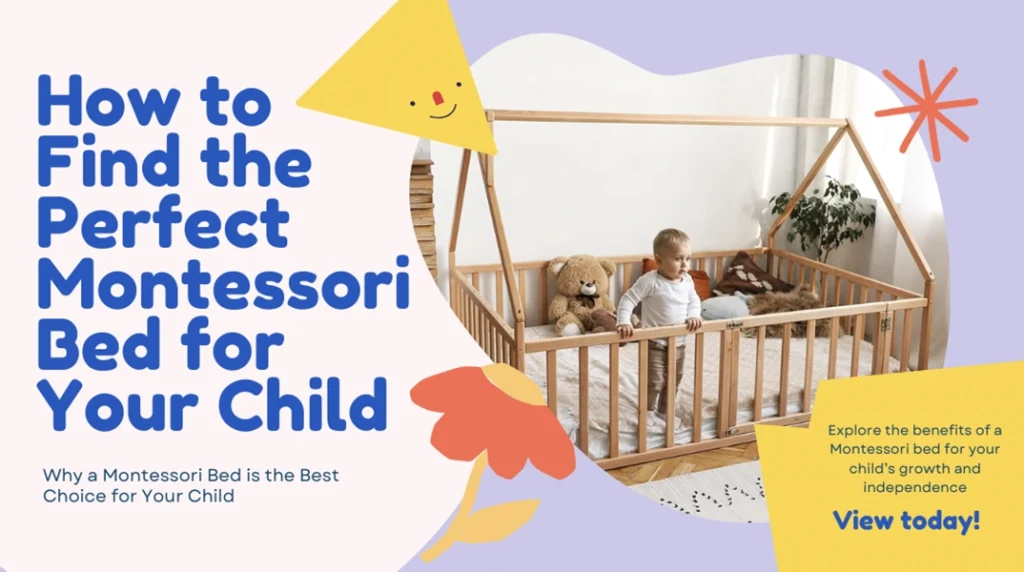As parents and caregivers, one of our most important roles is to create an environment that nurtures our children’s development. A growing trend in parenting is the shift towards Montessori principles, which emphasize fostering independence, autonomy, and self-directed learning. And when it comes to bedtime, many families are embracing the concept of Montessori beds, particularly the increasingly popular Montessori floor bed.
But what exactly is a Montessori bed, and why is it different from a traditional bed? How can it support your child’s development and encourage a good night’s sleep? Whether you’re a parent looking to transition your toddler, an educator wanting to implement Montessori practices in your classroom, or a business owner seeking to understand the benefits of Montessori furniture, this blog will provide valuable insights.
This guide will explore what makes Montessori beds unique, from their design features to their philosophy. We’ll delve into the various types of Montessori beds available today, such as the Montessori house bed or Montessori bunk bed, and why they might be the right choice for your child’s growing independence. By the end of this post, you’ll understand how these beds can transform bedtime and why they are becoming the go-to choice for modern families and educational environments.
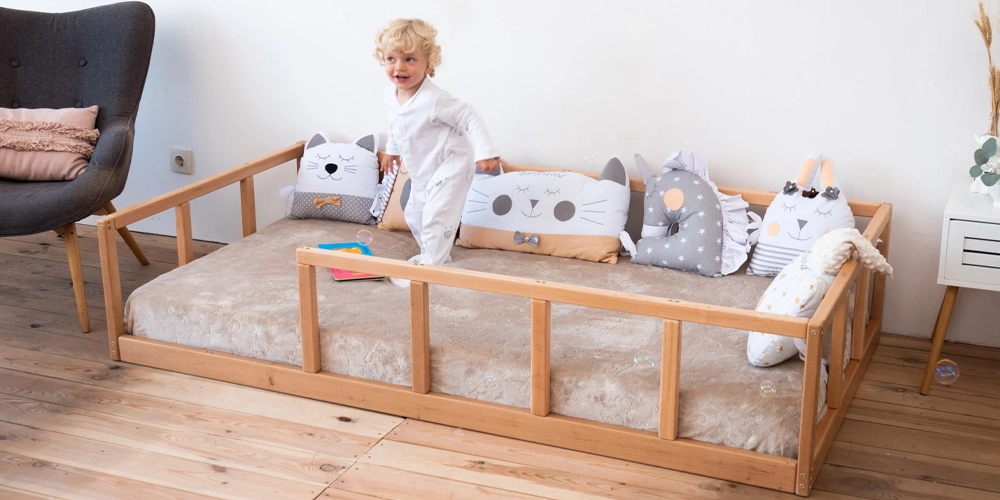
What is a Montessori Bed?
UN Montessori bed is explicitly designed to align with the Montessori philosophy, emphasizing self-directed learning, independence, and respect for a child’s natural development. Unlike traditional cribs or toddler beds with high rails or enclosures, a Montessori bed frame is typically low to the ground. This design gives children easy access to their bed, allowing them to climb in and out as they please — a key principle in encouraging autonomy.
In addition to the low height, Montessori floor beds usually have simple, minimalist designs with clean lines. The idea is to create a peaceful, clutter-free environment that supports the child’s ability to make independent choices and develop confidence. By allowing children to move about their space independently, Montessori beds help create an environment where children feel in control and safe without the constraints of traditional bed designs.
Growing Popularity of Montessori Floor Beds
One of the most popular choices among parents who follow the Montessori method is the Montessori floor bed with rails. These beds allow toddlers to sleep close to the floor, promoting freedom of movement, while the added rails provide safety and security. Over the past few years, the concept of Montessori floor beds has gained traction, with parents praising the ability of these beds to make the transition from crib to toddler bed smoother and less stressful for both the child and the parents.
Moreover, Montessori floor beds have become a staple in many modern homes and schools. They align with creating a child-centric environment where the child’s needs, including safety and comfort, are prioritized. Whether you’re looking for a Montessori bed for babies, a Montessori twin bed, or a Montessori bed with storage, the key is to find a bed that fits your child’s age, size, and personality.
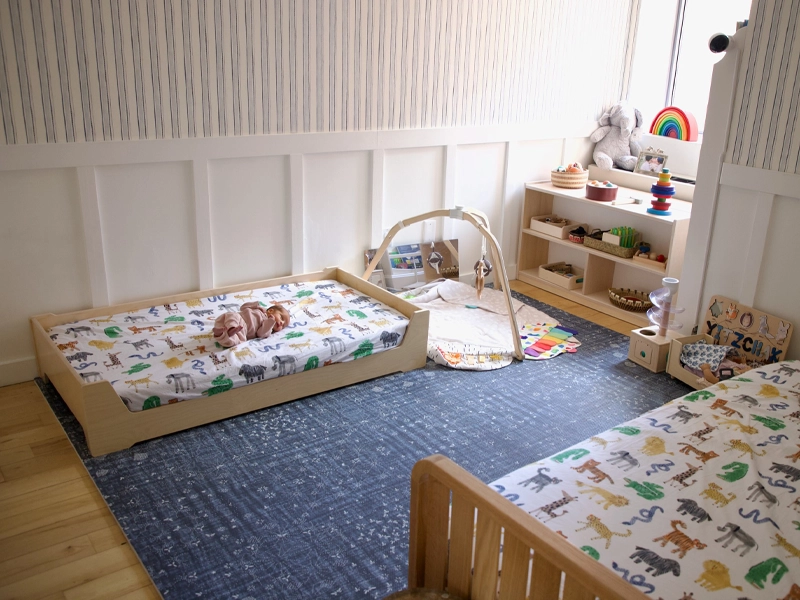
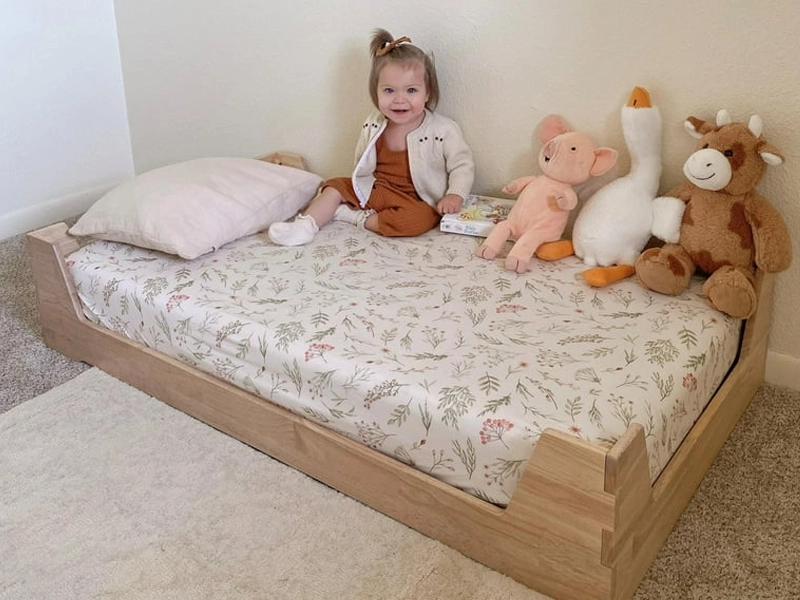

What Makes Montessori Beds Unique?
Montessori beds are more than just a place for children to sleep. They represent an essential part of a child’s development, offering comfort and an opportunity to grow in a supportive, child-centered environment. Let’s dive deeper into the distinctive features that set Montessori beds apart from traditional designs.
Understanding Montessori Bed Features
When you choose a Montessori bed, you’re opting for a design that supports your child’s natural development. From the Montessori bed frame to the layout of the bed itself, the unique features of these beds have been carefully crafted with the child in mind.
Montessori Bed Frame
The Montessori bed frame is intentionally minimalistic, typically designed to be low to the ground. Unlike standard bed frames, which are elevated with bulky rails, the Montessori bed frame is simple and functional. It often features clean lines and an open structure, promoting freedom and autonomy. This design allows children to feel empowered to enter and exit their bed as they wish, giving them control over their sleep environment.
Materials used for the Montessori bed frame are typically natural and durable, such as wood, which is gentle, non-toxic, and easy to clean. Popular choices include birch Montessori floor beds, which combine beauty and functionality. The frame’s design ensures no obstacles to freedom, creating a serene, safe, and welcoming sleep environment.
Lit au sol Montessori
One of the most defining features of Montessori beds is the Montessori floor bed. Placing a child’s bed directly on the floor allows them to freely explore and engage with their environment. Without the barriers of traditional high rails, a Montessori floor bed promotes independence by encouraging children to climb in and out of bed at their own pace. This supports the core Montessori principles of fostering self-reliance and confidence.
UN Montessori floor bed can come in various forms, from simple low-profile designs to more playful options, like the Montessori house bed or Montessori tent bed, which add an element of fun while maintaining the low-to-the-ground concept. These beds allow children to develop a sense of ownership over their sleeping space, which can improve sleep quality and confidence.
Montessori Bed Style
The Montessori-style bed embraces simplicity and functionality. These beds are designed to be minimalist and non-distracting, focusing on comfort and calmness for the child. Using neutral colors and natural materials, Montessori-style beds provide a peaceful space where children can sleep soundly without being overwhelmed by bright colors or excessive decorations.
In addition, the Montessori-style bed encourages personalization. Many parents choose to decorate around the bed with natural, calming items like wooden toys, soft linens, or simple decor that reflects their child’s personality. The minimalist design, paired with creative freedom, fosters an inspiring and nurturing environment.
Low Height and Accessibility
One of the key benefits of a Montessori bed is the low height. Often elevated off the ground, traditional beds can be difficult for small children to access. In contrast, Montessori floor beds are designed to be as close to the ground as possible, ensuring that children can quickly get in and out of bed. This low height promotes accessibility, allowing the child to feel confident and independent as they move about their space.
The low height also adds a layer of safety, as it minimizes the risk of injury from falls. Since the bed is positioned close to the floor, there is little to no distance for a child to fall. For younger children or those just transitioning from a crib, the low profile of a Montessori bed is reassuring for parents, knowing that their child is in a safe and supportive sleep environment.
Montessori Floor Bed with Rails
For some parents, the idea of a completely open Montessori floor bed may seem daunting. In these cases, a Montessori floor bed with rails offers a solution. These beds combine the best of both worlds: the accessibility and independence of a floor bed with the added security of low-profile rails.
The Montessori bed with rails is ideal for toddlers learning to navigate their space and may need extra protection from rolling out of bed. These rails are typically not high or imposing but are designed to gently contain the child while allowing easy access to the bed. Whether you choose a Montessori floor bed with rails or a more open design, the goal is always to balance freedom and safety, providing a bed that encourages movement and independence without compromising security.
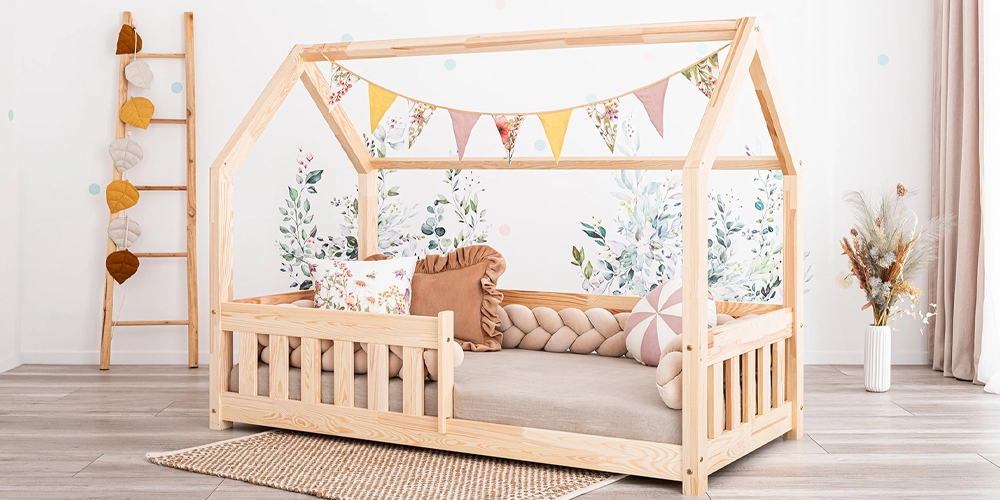
Montessori Bed Types and Designs
When choosing the right Montessori bed for your child, various styles and designs cater to different needs, preferences, and developmental stages. Let’s explore the different types of Montessori beds, including house, twin, bunk, and more.
Montessori House Bed
The Montessori house bed is one of the most popular and visually appealing designs for a Montessori bed. This bed resembles a small house, often with a roof structure that adds a playful and imaginative element to a child’s room. Montessori house beds are great for children transitioning from a crib to a bed, as the enclosed shape helps them feel safe while offering them the freedom to explore. These beds also encourage imaginative play, allowing children to see their bed as more than just a place to sleep.
The Montessori house bed is designed to be low to the ground, maintaining independence while providing a cozy, secure sleeping environment. It can come in various sizes, including Montessori twin bed and Montessori floor bed crib size, allowing you to choose the right fit for your child as they grow.
Montessori Twin Bed
The Montessori twin bed is another popular choice, especially for older children. Twin Montessori beds typically offer more space, which can be great for children who are getting taller and need more room to stretch out during sleep. These beds continue to emphasize the Montessori accessibility principles, with a low profile that allows the child to enter and exit the bed independently.
Some parents may opt for a Montessori twin bed with additional features, such as a Montessori bed with storage to help organize the child’s room. These beds combine style, functionality, and child-centered design, ensuring the bed grows with the child.
Montessori Bunk Bed
The Montessori bunk bed can be an ideal solution for families with more than one child. The Montessori bunk bed retains the core elements of the Montessori method while accommodating multiple children. Bunk beds are often designed with safety in mind, featuring low rails or a low-height design to ensure children can safely climb in and out of the bed.
Montessori bunk beds often come with additional features, such as built-in stairs or drawers for storage. This makes them a practical and stylish option for children who share a room, ensuring each child has a safe, accessible space to sleep.
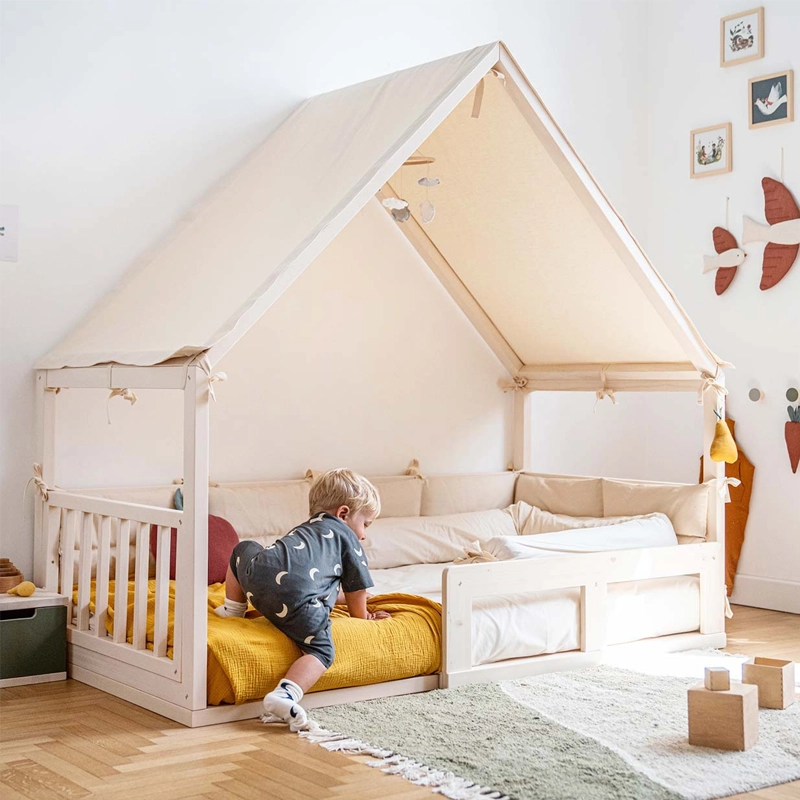
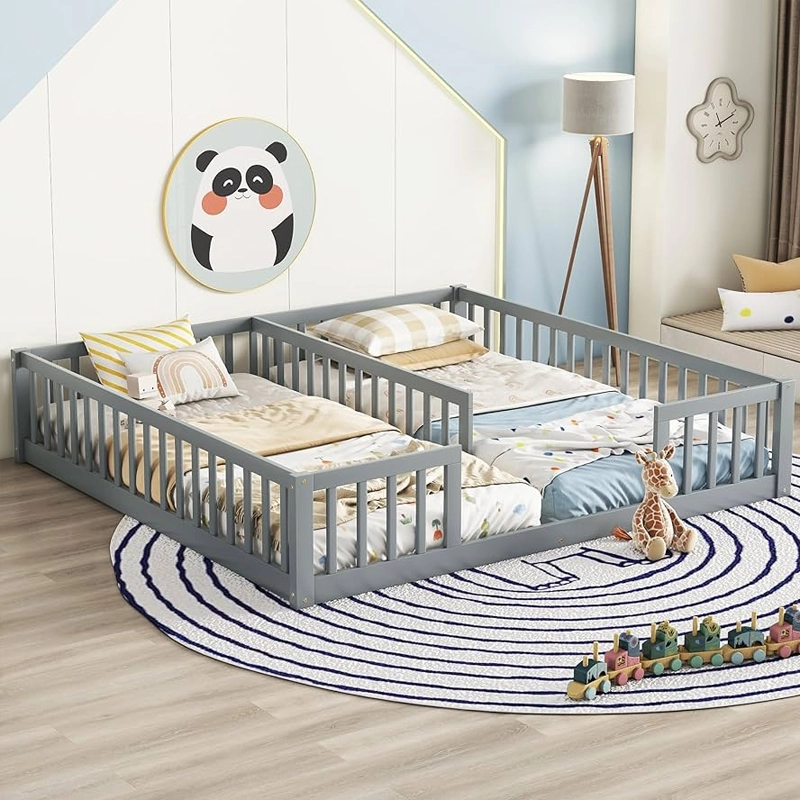
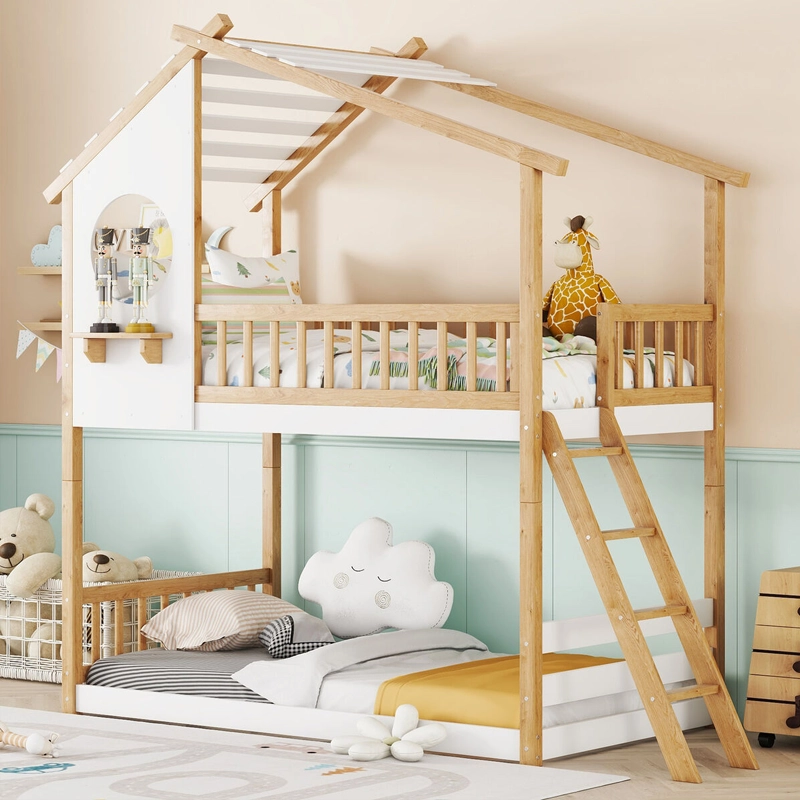
Montessori Floor Bed Crib Size
When choosing the right Montessori floor bed for infants or young toddlers, the Montessori floor bed crib size offers a fantastic solution. These beds are specifically designed to cater to babies transitioning out of a traditional crib, following the same child-centered principles of the Montessori method but scaled to fit the needs of younger children.
What Makes the Montessori Floor Bed Crib Size Different?
A Montessori floor bed crib size is typically designed to be low to the ground, allowing babies to move freely in and out of bed as they develop motor skills and independence. Unlike traditional cribs, which can feel restrictive to a growing child, these beds allow babies to explore their environment while maintaining a sense of security.
Here are some key features that set the Montessori crib-size floor bed apart:
- Low Profile: The bed is close to the floor, typically around 6 to 12 inches in height, making it safe for babies to climb in and out on their own. This design promotes early independence and helps children develop confidence in navigating their space.
- Safety: The low height reduces the risk of falls, and many Montessori floor beds for infants come with optional safety rails or barriers to provide additional protection as babies move around in their sleep. Some parents also choose a Montessori bed with rails for added security, especially during the initial stages of the transition.
- Size: A Montessori crib-size floor bed usually measures 28 to 30 inches wide and 50 to 54 inches long. This size is right for babies and toddlers up to 2 or 3 years old, depending on their growth and development. The bed offers enough space for comfort while not too ample, which might overwhelm a younger child.
Montessori Floor Bed Size Comparison Table
| Montessori Bed Type | Width | Length | Height (from floor) | Tranche d'âge | Recommended Mattress Size |
|---|---|---|---|---|---|
| Montessori Floor Bed Crib Size | 28-30 inches (71-76 cm) | 50-54 inches (127-137 cm) | 6-12 inches (15-30 cm) | 6 months – 2-3 years | Standard crib mattress (28″x 52″) |
| Lit pour tout-petits Montessori | 30-36 inches (76-91 cm) | 55-60 inches (140-152 cm) | 6-12 inches (15-30 cm) | 1-4 years | Toddler mattress (28″x 52″) |
| Montessori Twin Bed | 38-42 inches (97-107 cm) | 75 inches (191 cm) | 6-12 inches (15-30 cm) | 3-7 years | Twin mattress (38″x 75″) |
| Montessori Floor Bed with Slats | 30-36 inches (76-91 cm) | 50-60 inches (127-152 cm) | 6-12 inches (15-30 cm) | 1-3 years | Custom mattress, often crib size |
| Full-Size Montessori Floor Bed | 54-60 inches (137-152 cm) | 75-80 inches (191-203 cm) | 6-12 inches (15-30 cm) | 4-8 years | Full mattress (54″x 75″) |
| Montessori Floor Bed with Rails | 30-36 inches (76-91 cm) | 50-60 inches (127-152 cm) | 6-12 inches (15-30 cm) | 1-4 years | Crib mattress (28″x 52″) |
- Explanation of Size Variations:
Width & Length: These measurements determine the bed’s overall dimensions, and choosing the right size ensures your child has enough space to move around comfortably. The Montessori floor bed crib size is the smallest, while a full-size Montessori floor bed offers more space for growing children. - Height: The low-profile design of all Montessori beds (including crib size) ensures the child can quickly get in and out independently. This low height is one of Montessori’s core principles, helping promote autonomy. Most beds are designed to be 6-12 inches tall to maintain safety while being accessible to young children.
- Age Range: Each bed size is suitable for different stages of child development. The Montessori floor bed crib size is typically best for babies transitioning from a crib. In contrast, Montessori twin beds and full-size Montessori floor beds are more suitable for older children who need more room to grow.
- Mattress Size: The mattress size is key for a perfect fit. The Montessori crib-size floor bed typically uses a standard crib mattress, while other bed sizes, such as twin or full, require a more significant mattress to provide adequate support.
Benefits of a Montessori Floor Bed Crib
Smooth Transition from Crib to Bed: The Montessori floor crib size is a gentle transition from a crib to a bed. Since it’s placed directly on the floor, babies can explore and learn how to get in and out of bed independently, just like older children with traditional Montessori floor beds. This can help reduce the anxiety of a sudden switch from a crib to a full-size bed.
- Promotes Independence Early On: Parents can encourage the development of independence by introducing the child to a floor bed in the Montessori style at an early age. Babies can freely get in and out of bed when they wake up or feel restless without relying on an adult for assistance.
- Comfortable and Safe Sleep Environment: Many Montessori floor bed mattresses are designed to fit perfectly in these smaller-sized beds, offering optimal comfort for babies. This helps them develop healthy sleep habits by ensuring a supportive, safe, and comfortable environment.
- Helps with Exploration: As babies become more mobile, they naturally begin exploring their surroundings. A Montessori floor bed crib size gives them the freedom to crawl, stand, or walk around their sleeping space without being confined. This allows for early exploration and movement, both essential cognitive and motor development aspects.
When to Transition to a Montessori Floor Bed Crib Size
The ideal time to transition to a Montessori floor bed is usually around 6 to 12 months, depending on your child’s developmental milestones. Some parents introduce a Montessori crib-size floor bed as soon as their baby can sit up or stand, while others may wait until their child is more mobile or ready to climb out of the crib.
The Montessori bed age range for this type of bed typically extends from the first year of life until about 2 to 3 years old. After this, the child may be ready for a larger Montessori floor bed toddler or even a Montessori twin bed, depending on their size and developmental needs.
Ne vous contentez pas de rêver, concevez-le ! Discutons de vos besoins en mobilier sur mesure !
Why Choose a Montessori Bed for Your Child?
Now that we’ve explored the various types of Montessori beds, let’s look at why a Montessori bed might be the best choice for your child. From promoting independence to fostering healthier sleep habits, there are many benefits to choosing a Montessori bed.
Montessori Bed Benefits: Promoting Independence and Confidence
One of the key principles of the Montessori philosophy is fostering independence. Montessori beds support this by allowing children to move freely in and out of bed without assistance. This can be a significant confidence booster for toddlers, who feel empowered to decide when to get up or sleep.
Choosing a Montessori bed for toddlers encourages your child to own their sleep space. Whether it’s a Montessori floor bed or a Montessori house bed, the low-profile design enables children to learn self-regulation, building essential life skills at an early age. Montessori floor beds also help children become more aware of their environment, enhancing their problem-solving skills and physical coordination.
Are Montessori Floor Beds Safe?
Safety is a common concern for parents when transitioning to a Montessori floor bed. Are Montessori floor beds safe? The answer is yes, as long as the bed is designed correctly and in a secure environment. Montessori floor beds are low to the ground, which minimizes the risk of injury from falls. Additionally, many Montessori floor beds feature safety elements such as a Montessori floor bed with rails or soft bumper pads to provide extra protection, especially for toddlers who may be more prone to rolling out of bed.
It’s essential to ensure that the Montessori floor bed is placed in a clear, hazard-free area with adequate space. The low height makes it safer than traditional elevated beds, and many parents find that their children sleep more peacefully, knowing they have the freedom to move around without the risk of falling from a high surface.
Health Benefits: Better Sleep Habits and Comfort
The benefits of a Montessori floor bed go beyond just independence. An adequately designed Montessori bed mattress provides ample support, ensuring your child has a comfortable and restful night’s sleep. The Montessori bed mattress is often firmer than standard toddler mattresses, supporting healthy posture and spinal alignment.
The independent nature of a Montessori floor bed can also contribute to better sleep habits. Children can self-soothe and fall asleep on their terms, improving sleep quality and duration. Montessori floor beds help create a calm, comfortable, and supportive sleep environment by reducing the stress of transitioning from a crib.
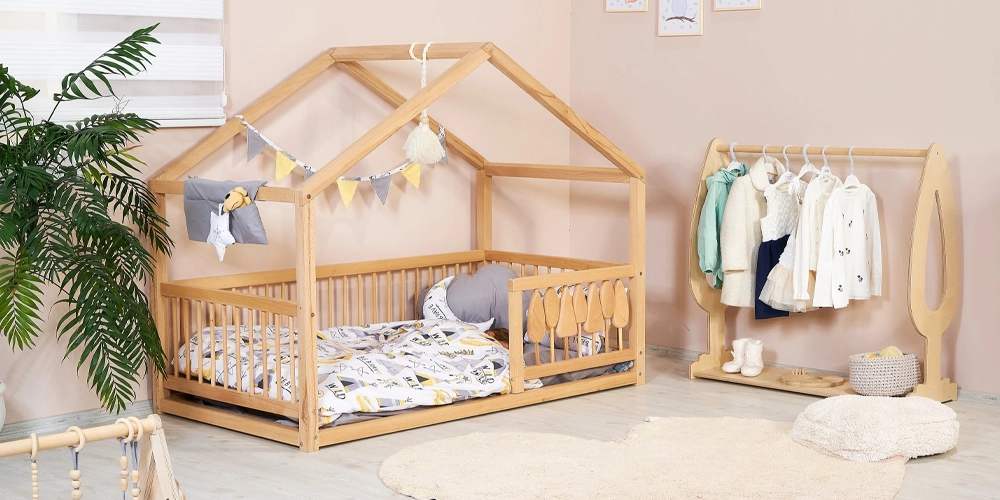
Choosing the Right Montessori Bed for Your Child
Choosing the right Montessori bed is pivotal for your child’s growth and development. It’s more than just a place to sleep—it’s a space that reflects the Montessori philosophy of independence, freedom of movement, and safety. This section will delve into key considerations to help you select the perfect Montessori bed for your child.
When to Start a Montessori Bed
One of the first questions parents have when selecting a Montessori bed is, “What is the right age for a Montessori bed?” Montessori bed age range typically starts from as early as 6 months, when babies are ready to transition from a crib. For infants and toddlers, Montessori beds provide the ideal sleeping arrangement by allowing them to move freely and explore their sleep space. It’s a great way to foster a sense of independence from an early age.
Montessori Bed 6 Months: When babies are around six months, they start developing motor skills like rolling over and sitting up. At this age, a Montessori baby bed or Montessori floor bed crib size is an ideal choice. These beds are low to the ground, making it safe for your baby to move around while preventing the risk of falling from a height.
When to Start Montessori Bed: As your child reaches 18 months to 2 years old, transitioning to a Montessori floor bed toddler can be a great option. This age range marks a key milestone where toddlers gain greater control over their movements and begin to explore their environment independently.
How Old for Montessori Bed: Typically, the transition to a Montessori bed for toddlers can be made around the age of 2. However, every child is different, and this can depend on your child’s readiness and developmental milestones.
Design Features to Consider
Design features play a crucial role in safety and functionality when choosing a Montessori bed. Here are the primary design elements to keep in mind:
- Low-Profile Design
The low-profile design is one of the defining features of a Montessori bed. Keeping the bed close to the ground reduces the risk of falls and allows children to get in and out of bed quickly. This feature supports the idea of self-sufficiency, which is central to the Montessori method. For younger children, having a low Montessori floor bed is essential, ensuring they can safely move in and out without assistance. - Safety Rails
Many parents opt for a Montessori floor bed with rails for added safety. This is especially important for toddlers who may still be developing balance and coordination. The rails provide a secure environment while promoting independence. A Montessori bed with rails is a great compromise for parents looking to offer both safety and the freedom that Montessori beds are known for. - Material Options
When selecting a Montessori bed, material choices matter, too. Wooden Montessori beds are popular for their durability, warmth, and natural aesthetic. For example, a birch Montessori floor bed is lightweight yet strong, offering beauty and practicality. Other materials, such as metal, can also be considered, but wood aligns better with the Montessori philosophy due to its natural and tactile qualities. - Additional Features
Modern Montessori beds often come with additional features, such as storage options. A Montessori bed with drawers or a Montessori bed with a trundle can be handy, especially in small spaces. These beds provide an organized, clutter-free space for children while still following the Montessori principle of simplicity. If you want to add extra functionality, Montessori beds with storage can be a fantastic choice to maximize your child’s room space.
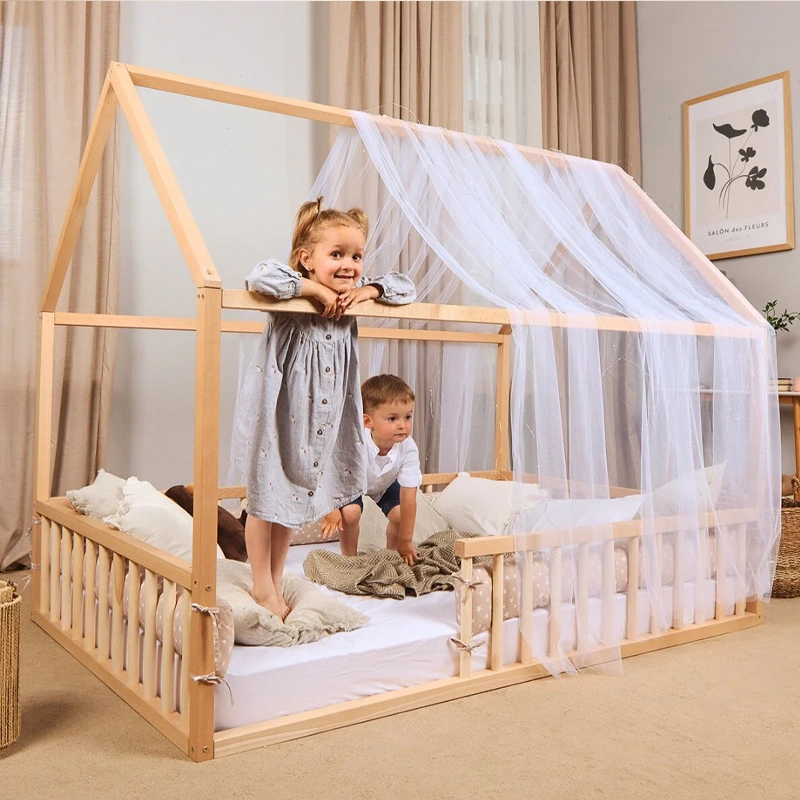
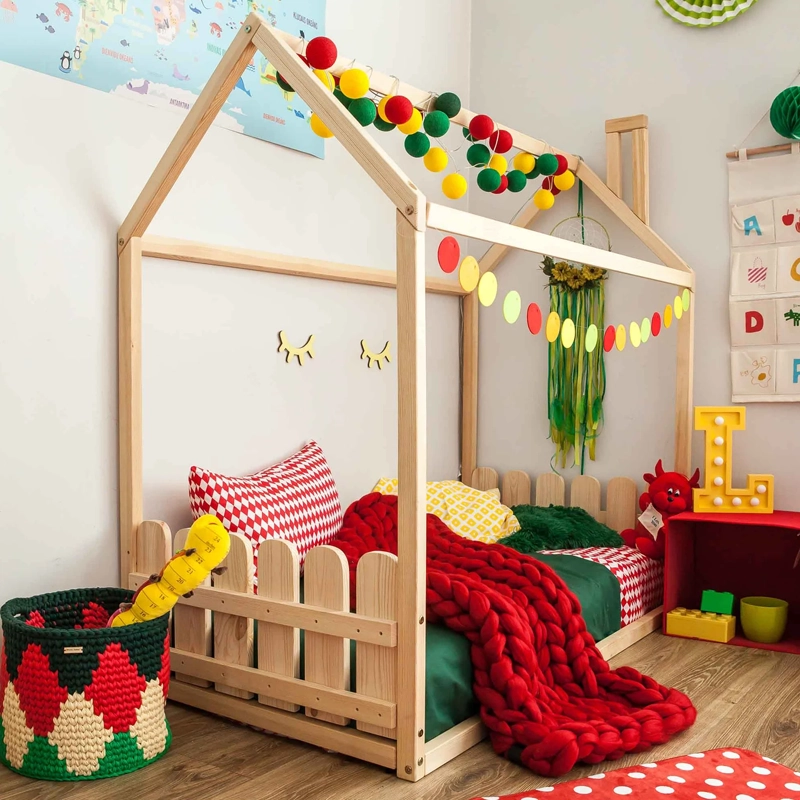
Montessori Beds for Babies and Toddlers
When choosing a Montessori bed for babies and toddlers, it’s essential to prioritize comfort, safety, and independence. Transitioning from a crib to a Montessori bed is an exciting milestone that can foster your child’s sense of autonomy.
The transition from a Montessori baby bed to a Montessori bed toddler is significant, marking your child’s growing independence and ability to sleep in a more open environment. Here’s what to keep in mind:
For Babies
When it comes to Montessori beds for babies, the goal is to create a safe, soothing, and accessible environment from the very beginning. A Montessori baby bed is typically a Montessori crib-size floor bed designed to help infants transition smoothly from a crib to a more independent sleep setup. The key is to ensure that the bed is low enough for babies to reach the floor quickly but secure enough to prevent any risk of injury.
Parents who choose a Montessori baby bed often find it easier to transition from crib to toddler bed, as babies are already accustomed to a bed that allows them to explore and move independently.
For Toddlers
As children grow and develop, their needs change. A Montessori bed for toddlers is ideal for parents looking to create a seamless transition from crib to bed. Montessori toddler beds maintain the same principles of independence and accessibility that the Montessori method emphasizes but are often slightly larger to accommodate a growing child.
Several options are available for parents looking for a Montessori bed for toddlers. Some may prefer a Montessori twin bed or full-size Montessori bed, which gives the child more space to grow. Others may opt for a Montessori bed with storage or a Montessori bed with drawers, which provides practical solutions for organizing toys and books while maintaining a child-centric design.
Montessori Baby Bed: For babies, a Montessori baby bed is typically a low, open structure that allows them to move freely while still being protected. The Montessori floor bed crib size is ideal for this stage. It helps babies adjust from the confined space of a crib to a more open bed, fostering a sense of freedom while still being close to the ground for safety.
Montessori Bed for 1-Year-Old: As your child nears 1 year old, transitioning to a Montessori bed toddler might be appropriate. At this age, toddlers can move around and gain independence in their sleeping environment. A Montessori floor bed for 1-year-olds is a good option, providing both safety and autonomy.
Montessori Floor Bed Crib Size: The Montessori floor bed crib size is particularly beneficial for young children transitioning out of their crib. The low-profile design helps them quickly access the bed, and since it’s close to the ground, it eliminates the risk of falls.
| Bed Type | Ideal Age Range | Features & Benefits | Key Design Element |
|---|---|---|---|
| Montessori Baby Bed | 6 months – 2 years | Low profile, open design, promotes freedom of movement, perfect for babies transitioning from crib | Low to the ground, open access |
| Montessori Bed Toddler | 1 year – 4 years | Encourages independence, safe environment, easy to enter/exit, fosters autonomy | Low profile, independent access |
| Montessori Bunk Bed | 3 years and up | Space-saving, great for siblings, can come with stairs for added safety | Bunk design, often with stairs |
| Montessori Car Bed | 2 years and up | Fun, creative design that engages imagination, low-profile for safety | Car-shaped, low to the ground |
| Montessori Tent Bed | 2 years and up | Creates a cozy, imaginative space, encourages independent play while maintaining safety | Tent/canopy design, low profile |
| Montessori Climbing Bed | 3 years and up | Promotes physical activity, motor skills, and independence; incorporates climbing structures | Built-in climbing features, low-profile |
You can confidently choose the Montessori bed that best suits your child’s needs by understanding the key factors such as age range, safety features, design preferences, and special functions. Whether choosing a Montessori bed for babies, transitioning to a Montessori bed for toddlers, or selecting a Montessori bunk bed for siblings, each bed type offers unique benefits to support your child’s growth and development.
Votre salle de classe idéale est à un clic !
Montessori Beds in Preschool and Daycares
Montessori beds are not just limited to the home environment; they are also being increasingly incorporated into schools and daycares, offering unique advantages that align with the Montessori philosophy of self-regulation, independence, and comfort. Understanding how Montessori beds can be used in educational settings helps highlight their versatility and effectiveness in fostering a conducive learning and resting environment for children.
How Montessori Beds Enhance Learning Environments in Schools and Daycares
Incorporating Montessori floor beds in schools and daycare centers offers children a restful environment consistent with the educational philosophy. In these settings, Montessori daycare beds are typically designed to foster autonomy and allow children to independently move in and out of bed, a key principle in Montessori education.
Montessori floor bed toddler setups are ideal for schools that focus on a child-centered approach, allowing toddlers to get up and down freely, explore their space, and transition from rest time to activity without external limitations. The idea is that by giving children the freedom to move independently within a secure environment, they develop a sense of self-awareness, responsibility, and confidence.
Benefits in Educational Settings:
- Fostering independence: Montessori beds, such as Montessori floor beds, encourage children to take responsibility for themselves from a young age by letting them choose when to rest or play.
- Resting without barriers: Children often sleep on regular cots or beds that might restrict their movements in traditional classrooms or daycares. A Montessori bed frame provides flexibility and security, allowing children to transition between rest and activity smoothly.
- Encouraging self-regulation: Montessori beds, with their low height and child-accessible design, allow children to regulate their sleep patterns and routines, which aligns with the Montessori approach to child independence.
Practical Considerations for Montessori Beds in Daycares and Schools
When selecting Montessori beds for a daycare or school environment, there are a few key factors to consider:
- Size and Space: The Montessori bed frame full or Montessori bunk bed with stairs may be appropriate for older children in more extensive educational settings. These beds are space-saving and practical, especially in daycares or schools with limited room.
- Durability: Schools and daycares require beds that can withstand heavy use. Birch Montessori floor beds and other sturdy materials are perfect, as they are both durable and safe.
- Caractéristiques de sécurité : For younger children, beds like the Montessori floor bed with rails provide added safety, ensuring that children are secure while encouraging movement and autonomy.
In Montessori daycares, it’s common to find Montessori floor beds specifically designed for toddlers. These beds help the children feel secure while sleeping, yet they allow easy access to move about when awake. Unlike traditional cribs, the Montessori floor bed crib size ensures that babies and toddlers have a safe, soft space to rest while enjoying the freedom of movement as they grow.
DIY Montessori Bed in Educational Settings
While Montessori beds are highly functional and efficient for educational settings, some schools or daycares may choose a more cost-effective solution by building their own DIY Montessori bed. A DIY Montessori floor bed allows the school or daycare center to customize the design to suit their space and children’s needs. Additionally, DIY Montessori bed plans are widely available online, giving educators the tools to build simple, sturdy beds.
Building a DIY Montessori bed for an educational setting involves simple materials such as wood and soft mattresses. These beds can be made to fit a specific size, and features like storage drawers or trundle beds can be incorporated for practicality.
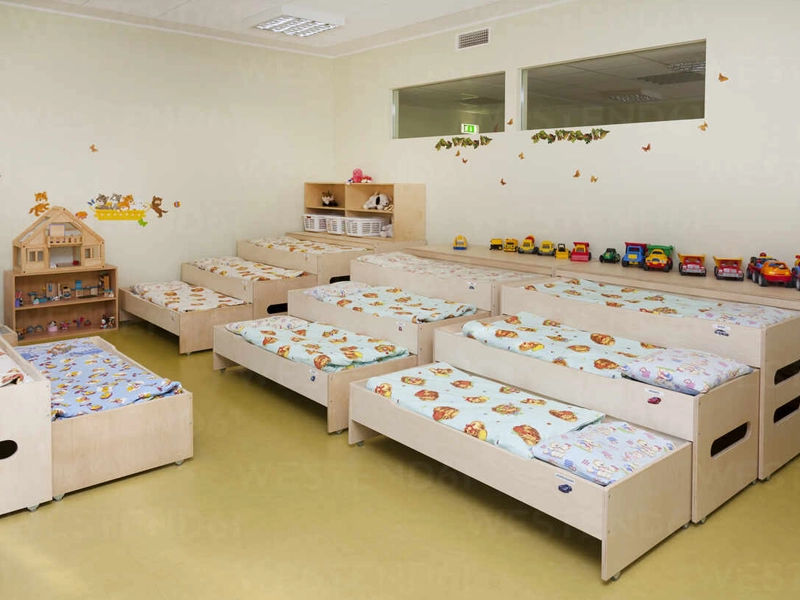
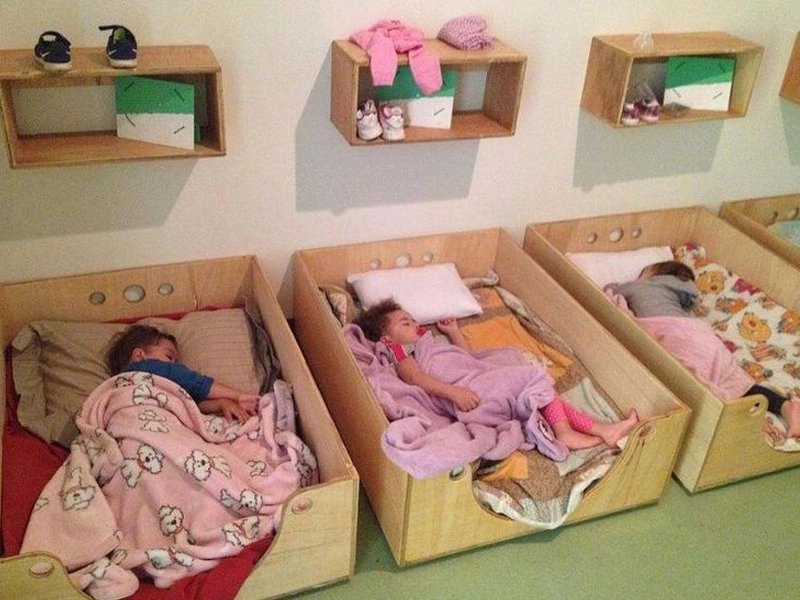
Conclusion
Choosing the right Montessori bed is more than just about aesthetics or comfort—it’s a decision that reflects the values of the Montessori philosophy and supports your child’s development. By selecting a Montessori floor bed, whether it’s a Montessori house bed, Montessori bunk bed, or a DIY Montessori bed, you’re creating a space that prioritizes independence, freedom of movement, and self-regulation.
Key Benefits of Montessori Beds
- Independence and Autonomy: A Montessori floor bed allows your child to explore their space. Children can get in and out of bed independently, promoting autonomy from an early age.
- Safety: The low-profile design of Montessori floor beds ensures your child’s safety while allowing them to move around freely. The risk of falling is minimal, and many beds, like the Montessori floor bed with rails, add an extra layer of security.
- Healthy Sleep Habits: The Montessori bed promotes healthy sleep by promoting a natural sleep environment. Montessori mattresses often come in ergonomic designs that support your child’s growth and provide the comfort they need for restorative sleep.
By adopting a Montessori bed, you align with the educational principles of the Montessori method, which values the development of independence, respect for the child’s autonomy, and fostering a stimulating and secure environment. Whether it’s the introduction of a Montessori bed toddler or transitioning your baby to a Montessori baby bed, this decision provides a nurturing environment that supports their growth, development, and exploration.
Consider the Right Time to Transition to a Montessori Bed
- When to Start Montessori Bed: The Montessori bed age range is flexible, and many parents transition their children to a Montessori floor bed as early as 6 months or when they begin to show signs of crawling or standing up. For toddlers, the Montessori bed toddler is a perfect choice that allows for further development of autonomy.
- Choosing the Right Bed: Understanding the purpose of each Montessori bed style, from Montessori house beds to Montessori bunk beds, will help you select the ideal bed for your child’s needs. Each design offers unique features that support your child’s growing independence, like Montessori beds with drawers for additional storage or the Montessori bed with a trundle for convenience.
Supporting Healthy Development and Well-Being
Opting for a Montessori bed aligns with the overall philosophy of child-centered development. As your child grows, their needs will evolve, and having the right Montessori bed frame can help them navigate their development in a natural, child-friendly way. Whether choosing a Montessori twin bed for older children or a Montessori baby bed for your newborn, each bed design fosters a sense of control, security, and comfort.
In schools and daycare settings, Montessori beds for daycares and Montessori floor bed toddler setups are becoming increasingly popular. These beds help maintain the same principles of independence and freedom in educational settings, allowing children to explore and rest at their own pace.
Take the Next Step with Montessori Beds
As a parent, educator, or business owner, embracing the Montessori philosophy by investing in the right bed can significantly benefit the child’s well-being. It’s not just about creating a comfortable place to sleep—it’s about creating a space that nurtures autonomy, fosters healthy habits, and aligns with the educational philosophy of independence and exploration. Don’t hesitate to inquire about Montessori bed plans or explore the best options for your child with trusted Montessori bed suppliers.
Votre salle de classe idéale est à un clic !
In this comprehensive guide, we’ve explored the transformative benefits of Montessori beds, a thoughtful sleep solution grounded in the Montessori philosophy of promoting independence, freedom of movement, and self-discovery. Whether you’re a parent, educator, or caregiver, choosing the right Montessori bed can profoundly impact a child’s development, setting the foundation for a confident, independent, and self-sufficient mindset as they grow.
From the low-profile design of Montessori floor beds to the variety of styles like the charming Montessori house bed or more space-efficient Montessori bunk beds, each design caters to different age ranges and developmental needs. We’ve covered how the Montessori floor bed crib size makes the transition from crib to bed smoother for babies, while Montessori twin beds and Montessori full beds offer growing children the freedom to stretch and move, in line with the Montessori method.
Key considerations, such as mattress compatibility, height, and bed safety features, play an essential role in choosing the perfect bed. The benefits of a Montessori bed are clear: it fosters autonomy, promotes better sleep habits, and encourages independence right from the start. As discussed, there’s a Montessori bed for every child, whether you’re looking for something safe and accessible for a toddler or a more significant, more personalized option for an older child.
We’ve also looked at the growing trend of Montessori beds in schools and daycares, illustrating how these beds contribute to a child-centric environment supporting emotional and physical growth in educational settings. In the classroom or at home, Montessori beds for toddlers and Montessori bunk beds foster greater independence and teach children the importance of personal responsibility.
Moreover, for those who enjoy a hands-on approach, the DIY Montessori bed offers a customizable, cost-effective solution without compromising quality or safety. Parents can build their beds with simple steps, adding a personal touch to the Montessori experience.
Choosing a Montessori-style bed isn’t just about aesthetics; it’s about creating a nurturing environment where children are encouraged to take charge of their space and cultivate the confidence to explore their world. As you consider options like Montessori beds with storage, Montessori beds with trundles, or unique designs like the Montessori climbing bed, remember that the perfect bed can support your child’s developmental milestones and your family’s needs.
In conclusion, Montessori beds are more than just a sleeping arrangement—they represent a shift in how we approach childhood development, teaching children the skills of independence and self-regulation in a safe, comfortable environment. Whether you’re just beginning to explore Montessori principles or already integrating them into your home, choosing the right Montessori bed is essential to fostering growth and freedom.
If you’re ready to transition or add a Montessori bed to your home or educational setting, we encourage you to consider the various styles and sizes discussed here. Embrace the Montessori philosophy by investing in a bed that fits your space and nurtures your child’s autonomy. Contact us today for more information on high-quality Montessori beds in various styles, sizes, and materials to suit every child’s needs.

